As I research and go deeper into the history of Kyokushin Karate I become even more fascinated. Between legend and story, somewhere lays the truth. We may never know fully, but it is wonderful to speculate, learn and share.
This happened recently, when a reader, Terry Birkett, 4th Dan Kyokushin Karate, of Ronin Dojo in Wales, was asking me about Sosai Mas Oyama’s rank in Goju-ryu. I knew it had come from Gogen Yamaguchi, based on an interview Graham Noble did with his son in 2013, so I assumed that is where Sosai learnt Goju. I was wrong. Terry pointed me in the direction of Nei-chu So, which then led me on a path of researching Sosai Mas Oyama’s training in martial arts and here now lies what I have found out so far.
While there is writing about Sosai training as a youth, at his sister’s farm where he was sent, I am going to focus more on the training her undertook after moving from Korea to Japan.
Zainichi (Korean-Japanese) before the War
Before the Second World War, Korea was under the control of the Japanese empire. Though Korea was under oppression from Japan, used for its natural resources and built it up as an industrial center, many Koreans immigrated to Japan to advance their education and careers.
In those times the Japanese looked down on Koreans and discriminated against them. Despite this, many determined Korean youth traveled to Japan in the 1920s and 1930s in search of education, jobs and a better future.
Some of these Koreans later became founding fathers of Korean martial arts such as Tang Soo Do, Tae Kwon Do, and Hapkido. Some stayed in Japan and to become recognized for their martial arts. One of these was a Korean named Yeong-eui Choi, who would later change his name to Japanese, Masutatsu Ōyama, which was a common practice of Koreans migrating to Japan at that time.
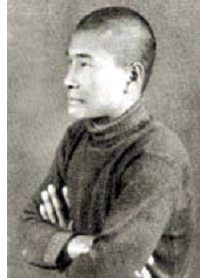
Oyama was born as Young-eui Choi in Gimje, South Korea, during Japanese occupation. As I mentioned earlier, at a young age he was sent to Manchuria, Northeast China to live on his sister’s farm. Oyama began studying Chinese martial arts at age 9 from a Chinese farmer who was working on the farm. His family name was Li and Oyama said he was his very first teacher.
In March 1938, at the age of 15, Young-Eui Choi left for Japan following his brother who enrolled in the Yamanashi Aviation School Imperial Japanese Army aviation school. Sometime during his time in Japan, Young-Eui Choi chose his Japanese name, Masutatsu Oyama (Ōyama Masutatsu – 大山 倍達). Oyama means ‘Great Mountain’ and Masutatsu means ‘Baedal’, which was an ancient Korean kingdom known in Japan during Oyama’s time as “Ancient Joseon”. He adopted the family name Oyama from the family that befriended him and took him in, while in Japan.
Judo:
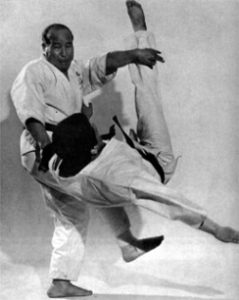
Though I could not find much information, Oyama took up Kosen Judo during his teens in Japan, which was extremely common at that time. First at the Kodokan Institute in Tokyo and then in the studio of the father of Koji Sone, who was Judo Champion of the World from 1959 to 1961.
It is also said that Masahiko Kimura, a famous champion of Judo, considered one of the greatest judoka of all time, who defeated He’lio Gracie of Brazilian Jiu-jitsu, encouraged Oyama to take up Judo so that he would have an understanding of the art’s ground techniques. Besides Judo, Masahiko Kimura studied Goju-ryu under Nei-chu So, eventually becoming an assistant instructor. Kimura introduced Oyama to the Sone Dojo in Nakano, Tokyo, where he trained regularly for four years, eventually gaining his 4th Dan.
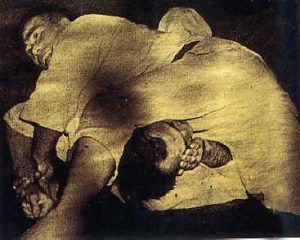
In submission grappling, the reverse ude-garami arm lock is often called the “Kimura“, due to his famous victory over Gracie jiu-jitsu developer Hélio Gracie.

5th Dan at age 18
Kimura also studied karate under Gichin Funakoshi for a couple of years, but eventually switched to training Goju-Ryu Karate under So-Nei Chu finally became an assistant instructor, along with Gogen Yamaguchi and Masutatsu Oyama, in his dojo. Interestingly, in his autobiography Kimura, attributes the use of the makiwara as taught to him by Nei-chu So and his friend and training partner Masutatsu Oyama, as being a significant contributor to his competitive judo success due to its strengthening effect on his hands. He began using the makiwara daily prior to his first All Japan success and never lost another competition bout.
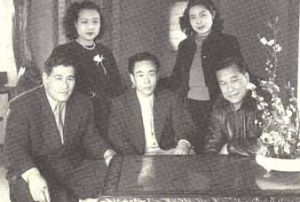
As a side story, after Kimura beat Gracie and returned to Japan, a match was made with famous pro wrestler, Korean born Rikidozan and the to parties came together scripted out a dramatic draw between the two legends. But then on the day of the fight Rikidozan went off script and a strike that was supposed to land on Kimura’s chest instead landed on his neck and then Rikidozan kicked Kimura in the head with a booted foot, knocking the Judoka out. Kimura’s friends were outraged and Oyama even offered to kill Rikidozan, but Kimura declined the offer.
Shotokan:
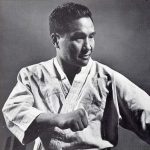
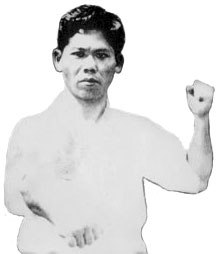
In 1946, Oyama enrolled in Waseda University School of Education to study sports science. It is here that he began studying Shotokan karate under Gigō (Yoshitaka) Funakoshi, the second son of Shotokan founder Gichin Funakoshi.
Later Oyama attended Takushoku University in Tokyo and was accepted as a student at the dojo of Gichin Funakoshi. He trained with Gichin Funakoshi for two years. Oyama progressed to 4th Dan, under Sensei Funakoshi.
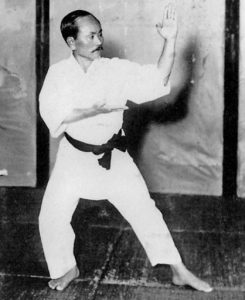
With this being said, it is believed that Oyama did not have much respect for Funakoshi’s teaching. “It’s not karate. What he taught me was etiquette and exercise. Too slow”. Oyama described Funakoshi as “soft and gentle, good for teaching karate to little children like he did in Okinawa. But he’s not a real karateman. It was all kata with the old man”.
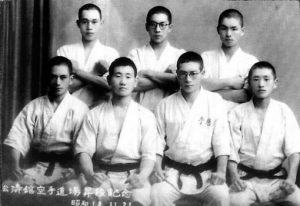
Sometime during this era of Oyama’s karate instruction the Shotokan students in Tokyo began to hear about the tough fighters practicing a different style in Osaka, called Goju-ryu. According to a widespread story, also told by Oyama, Gichin Funakoshi’s son Gigō picked 10 of his best students and traveled to Osaka to engage in an inter-school match. All of Funakoshi’s students lost to the Osaka students. At some point during this competition, apparently in the last match, Gigo Funak oshi fought someone named Nei-chu So.
oshi fought someone named Nei-chu So.
Apparently, the powerful So simply picked up the smaller Funakoshi and threw him against a wall, injuring not only his body but his dignity. It is said that after returning to Tokyo, the Shotokan schools intensified their study of kumite and stepped up its intensity, resulting in their later fearsome reputation in tournament competition. The story suggests that Goju karateka were more advanced in jiyu-kumite.
After this event Oyama said of Gigō. . . “Funakoshi’s son became a real karate fighter. Very strong. I like. He use to tell me ‘karate is kumite’”
However, Oyama would always refer to Gichin Funakoshi as his true karate teacher and would later state that of all the things he learned from the founder of the Shotokan system, kata was the most important. Although, this is perhaps because he didn’t feel Funakoshi had more than kata to offer him.
Goju-ryu:
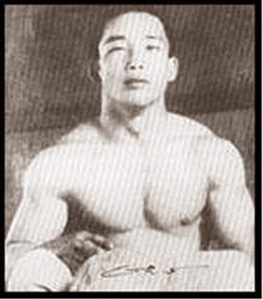
Apparently Funakoshi’s training wasn’t enough for the young powerful Oyama, and so after the end of World War II Oyama decided to leave and study Goju-ryu under fellow Korean Nei-Chu So.
Nei-Chu So, an ethnic Korean like Oyama, was a senior student of Goju-ryu’s founder, Chojun Miyagi. So was extremely important in helping Gogen Yamaguchi “The Cat” become established and in building his reputation in Japan, along with the karate style Goju-ryu. To this point, Goju-ryu was mainly an Okinawan system. Nei-Chu So kept Yamaguchi’s fledgling Goju school alive while Yamaguchi was stationed overseas during World War II and subsequently held as a prisoner of war in Russia. So remained a high-ranking official in Japanese Goju-ryu organizations after the War, even as Yamaguchi eclipsed him in fame.
Quiet and unassuming, Nei-Chu So was apparently very strong, muscular and a powerful fighter, who remained an important behind-the-scenes influence over Japanese Goju-ryu until his death in Japan around 2001. Aside from a few references to his huge influence on Oyama, not much is known about Nei-Chu So.
Accounts differ significantly about exactly what So’s relationship was with Gogen Yamaguchi. The “official” line from the later Yamaguchi camp has it that So was Yamaguchi’s top pupil and dai senpai. Others however have said that So was actually senior to Yamaguchi in karate, but that Yamaguchi-as a Japanese and because of his outgoing charismatic personality-took on the leadership role, relegating Nei-Chu So to a subordinate position.
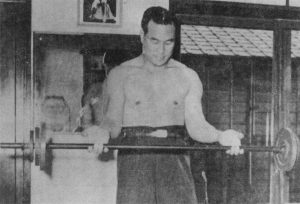 Whatever the truth is about his position in Goju-ryu, no one questioned his abilities and Oyama became a protégé of Nei-chu So. So influenced Oyama to train hard, lift weights to increase his strength, and engage in more realistic “jissen kumite,” but also urged him along the path of merging spirituality with his martial arts.
Whatever the truth is about his position in Goju-ryu, no one questioned his abilities and Oyama became a protégé of Nei-chu So. So influenced Oyama to train hard, lift weights to increase his strength, and engage in more realistic “jissen kumite,” but also urged him along the path of merging spirituality with his martial arts.

After the War and his release from a Russian prison camp, Gogen Yamaguchi returned to Japan and settled in Tokyo. Mas Oyama trained from time to time with Gogen Yamaguchi, even joining the latter’s Goju-kai and obtaining the rank of 7th Dan Black Belt. Though So remained Oyama’s main teacher, and Oyama would eventual branch off on his own to create his own style of karate,
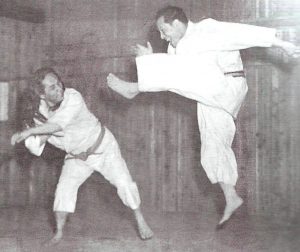
Yamaguchi and Oyama remained friends and their students would sometimes visit each other’s dojos.
Nei-chu So remained active in the original Goju-kai set up by Gogen Yamaguchi, apparently as the Vice-President of the organization. At some point, he reportedly was promoted to 9th dan by the Japanese Butokukai. In addition to his karate career, Nei-chu So was also active in the principal association of Koreans in Japan, looking out for their interests. So apparently died in Japan sometime around 2001, in his early 90s, his major early role in the development and spread of karate in Japan all but forgotten.
Nei-chu So was a great influence on his fellow native countryman Yeong-eui Choi (Masutatsu
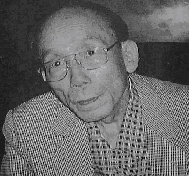
Ōyama). The defeat of Japan and the subsequent indignity of Occupation almost proved to be too much for Mas Oyama, who nearly despaired. Nei-chu So encouraged Mas Oyama to dedicate his life to the Martial Way. It was he too who suggested that Oyama should retreat away from the rest of the world for 3 years while training his mind and body.

In his book, What is Karate?, Oyama wrote, “When I was driven almost to self-ruin, Mr. So Nei-Chu, an elder of my native province, rescued me from the crisis. Mr. So, a thinker and master of karate, was a rare man of character and confidence. Moreover, he was a devotee of the Nichiren Sect. He preached to me that martial arts and religion are inseparably united and taught me the scripture of his sect.
When I was at my wits’ end as to what to do and went to see him, Mr. So, after encouraging me, said, ‘You had better withdraw from the world. Seek solace in nature. Retreat to some lone mountain hide out to train your mind and body. In three years you will gain something immeasurable. As the proverb goes, “Temper the heated iron before it gets cold, so train yourself in self discipline before you grow older if you wish to be a great man.”‘
When I heard Mr. So’s advice, I felt as if I had been awakened and I suddenly understood the path to take. The Oriental Confucian maxim is: ‘First train one’s self, manage a household, and then reign of over a country.’ It is essential to train one’s self if one wants to administer the affairs of state wealth.
To Mr. So, I shall forever be grateful for his advice and instruction which made me what I am as a karate master. I made up my mind to concentrate on the difficult road ahead. I reviewed all the futile actions I had taken in the past and decided, as advised by Mr. So, to isolate myself at Mt. Kiyozumi in Chiba Prefecture.“
Words of Masutatsu ‘Mas’ Oyama from his book “What is Karate?”
Musashi and Mountain Training:
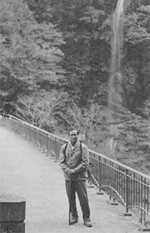
Oyama also met Eji Yoshikawa, author of the book ‘Musashi’, a fictionalized account of the life of Miyamoto Musashi, Japan’s most famous samurai warrior. Thanks to this book and the writer, Mas Oyama begins to understand the profound meanings of the Samurai Bushido Code, and ultimatemly shapes his own philosophy on martial arts.
Influenced by Nei-chu So and the writing of Yoshikawa, Mas Oyama decided to withdraw from social life and live in solitude for a period of 3 years and dedicate his time completely to the intense training of body and mind, as Musashi did in his lifetime. Oyama traveled to Minobu mountain, the same place where Musashi created Nito-ryu kenjitsu. Mas Oyama was only 23 years old at the time. In his opinion this would be the perfect place to start his severe training of body and mind that he had planned for himself.
Accompanied by one of his students, Yashiro, and assisted by a friend who provided them with the monthly food supplies they went to the wilderness to train. After 6 months however Yashiro decided to return to civilization, overwhelmed by loneliness he leaves Oyama alone. After 14 months of training, his sponsor and friend sends a message to Oyama that he can no longer help him with his monthly food supplies. Because of this Oyama stops his training and returned to civilization.
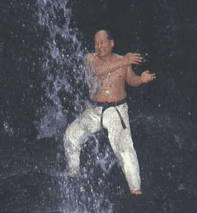
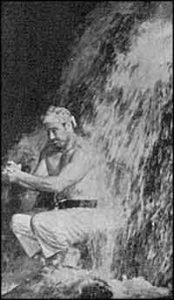 A few month’s later, in 1947, Mas Oyama participated in the Karate division of the “1st Japanese National Martial Arts Championships” after WWII and wins. After this victory Oyama decided to dedicate the rest of his life to karate and again returns to the wilderness for training. This time he went to the Kiyozumi Mountain, also in the prefecture of Chiba. Accorfing to Oyama, his training was very intense and rigorous. Training for about 12 hours a day. He trained standing below ice-cold waterfalls, breaking river stones, using trees as his makiwara, etc.
A few month’s later, in 1947, Mas Oyama participated in the Karate division of the “1st Japanese National Martial Arts Championships” after WWII and wins. After this victory Oyama decided to dedicate the rest of his life to karate and again returns to the wilderness for training. This time he went to the Kiyozumi Mountain, also in the prefecture of Chiba. Accorfing to Oyama, his training was very intense and rigorous. Training for about 12 hours a day. He trained standing below ice-cold waterfalls, breaking river stones, using trees as his makiwara, etc.
Oyama also spent hours reading and studying, including Zen Buddhism and

other philosophies. His goal was to create a martial art going back to the origins of the true samurai way of fighting. During these 18 months of rough and intense training Mas Oyama combined the most effective techniques of different systems and made up his own unique style. After this time he returned back to society as a completely different man. Mentally, Physically and Spiritual.
Taikiken:
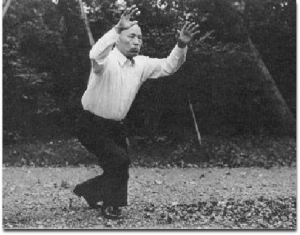
Taikiken is a Japanese martial art, greatly inspired by Yi Quan (or dachengquan), a Chinese system of martial arts. Taikiken was founded by the Japanese Kenichi Sawai (1903 – 1988) after losing to Chinese Wang Xiangzhai (1885-1963) – the founder of Yi Quan. Impressed by the technique of Wang Xiangzhai, Kenichi Sawai learned Yi Quan with his student Wang Yao Zongxun and then with the master himself, Wang Xiangzhai.
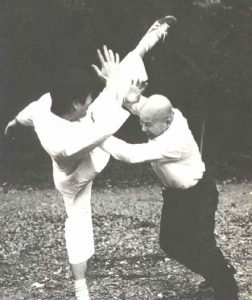
Kenichi Sawai began transmitting his art at the end of his learning of Yi Quan in 1947 in Japan. Among his most famous students was his long time friend Mas Oyama, whose friendship went back to their University Judo days, as well as Oyama’s top student, Hatsuo Royama, who became one of Sawai Sensei’s top students as well.
Taikiken was one of the arts assimilated into the creation of Kyokushin by Mas Oyama in the very beginning. It was part of the original Kyokushin synthesis. It has always been a part of Kyokushin, and, if anything, its practice was lost among Kyokushin karateka during the years that Kyokushin’s popularity boomed.
Oyama Dojo:
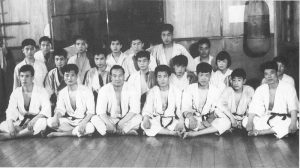 In 1953 Mas Oyama started his first dojo in the outdoors in Mejiro, a suburb of Tokyo, but June 1956 is considered as the official start of the Oyama karate school, opening his dojo behind the Rikkyo University, about 500m away from the spot that would become the actual honbu dojo.
In 1953 Mas Oyama started his first dojo in the outdoors in Mejiro, a suburb of Tokyo, but June 1956 is considered as the official start of the Oyama karate school, opening his dojo behind the Rikkyo University, about 500m away from the spot that would become the actual honbu dojo.
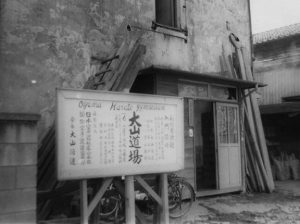
In 1957 there are about 700 members training at his dojo, despite the high attrition due to the hard training. Practitioners of other martial arts also came to train at his dojo, especially for the jis-sen kumite (full contact fighting). Mas Oyama observed these styles and adopted the best and most useful techniques into his karate. Doing so, his Karate evolved soon into one of the most impressive styles in the world of martial arts. Soon his style was known as “The Strongest Karate”, not only thanks to the skill and endurance of Oyama, but also because of the strong and strict discipline and the requirements for training and tournaments.
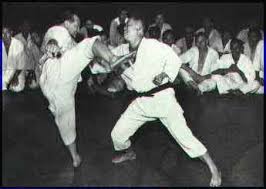 Oyama Dojo members took their kumite very serious, conscious that they were practising a fighting sport and expected to be hit and to be able to hit. With few rules and restrictions they fought with stikes to the head with the palm or fists wrapped in towels. Throws, grappling and kicks, were allowed, even to the groin was normal practice. The Kumite continued until one of the competitors was knocked out, or surrendered and gave up. It was one of the first true mixed martial arts.
Oyama Dojo members took their kumite very serious, conscious that they were practising a fighting sport and expected to be hit and to be able to hit. With few rules and restrictions they fought with stikes to the head with the palm or fists wrapped in towels. Throws, grappling and kicks, were allowed, even to the groin was normal practice. The Kumite continued until one of the competitors was knocked out, or surrendered and gave up. It was one of the first true mixed martial arts.
Kyokushin Karate:
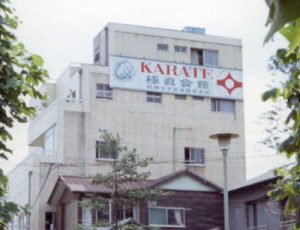
In 1964 Oyama moved the dojo into the building that would from then on serve as the Kyokushin home dojo and world headquarters. The IKO (International Karate Organization)
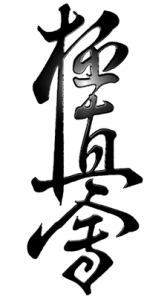
adopted the name of “Kyokushin”, or “The Ultimate Truth” as the name for Oyama’s karate. Before 1963 Oyama had called his karate Oyama Karate. From that moment Kyokushin Karate started to spread out all over the world.
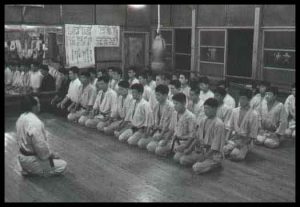 In 1969, Oyama staged the first All-Japan Full Contact Karate Open Championships which took Japan by storm and Terutomo Yamazaki became the first champion, which have been held every year since. In 1975, the first World Full Contact Karate Open Championships were held in Tokyo. World championships have been held at four-yearly intervals since.
In 1969, Oyama staged the first All-Japan Full Contact Karate Open Championships which took Japan by storm and Terutomo Yamazaki became the first champion, which have been held every year since. In 1975, the first World Full Contact Karate Open Championships were held in Tokyo. World championships have been held at four-yearly intervals since.
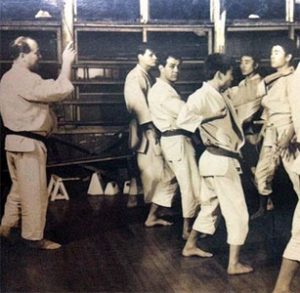
Oyama wanted to spread Budo Karate and sent instructors to other countries such as the United States, Netherlands, England, Australia and Brazil to spread Kyokushin. Oyama also promoted Kyokushin by holding The All-Japan Full Contact Karate Open Championships every year and World Full Contact Karate Open Championships once every four years in which anyone could enter from any style.
Please note I do not profess to know the “truth” of Sosai Mas Oyama’s training, but rather relaying information that I have collected in my own research. Unfortunately, Sosai’s time was before the internet and mass media, so much is lost to history. If you have further information I invite you to please leave comments below.
Osu!
Further reading:
Black Belt – Oct 1971 – Page 46
Black Belt – Summer 1963 – Mas Oyama Speaks Out
Black Belt – Apr 1994 – The Living Legend
http://www.historyoffighting.com/mas-oyama.php
Black Belt – Summer 1963 – Karate At Its Most Rugged
http://www.karatekan.com/masutatsu_oyama.html
http://www.bjjee.com/articles/the-legend-masahiko-kimuras-amazing-training-routine/
https://iainabernethy.co.uk/content/masahiko-kimura
http://seinenkai.com/articles/noble/noble-oyama.html
http://budo.life/2016/04/29/masutatsu-oyama/
http://www.willingtonkarateclub.org/style/masoyamahistory1.html
http://beisho.org/historical_07.html
http://www.seinenkai.com/articles/noble/noble-gyamaguchi.htm
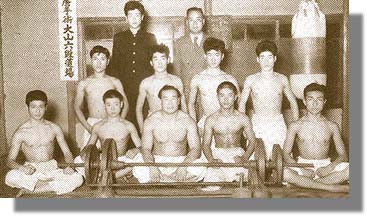
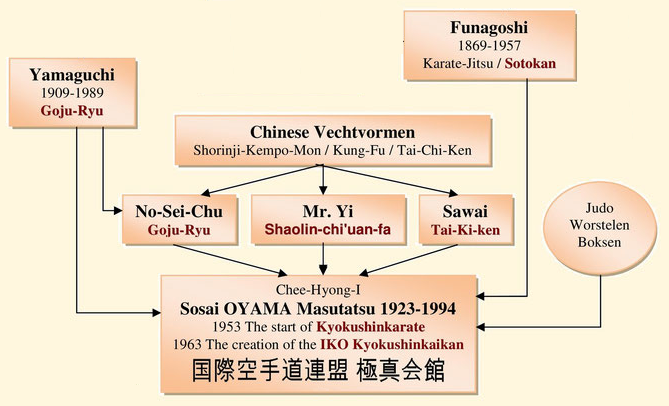
Hello Scott, I’ve enjoyed your site for some time, and it’s good to see your interviews are back. As a past researcher into karate’s history, and published author on the subject, I would ask that you be careful not to take as fact, things you read, especially about past masters of the school the writer happens to be associated with. Your announcement that the late Nei Chu So sensei was a “senior” student of Miyagi Chojun would have come as a surprise to Miyagi sensei’s students in Okinawa. Miyagi sensei visited mainland Japan on only three occasions, and never stayed… Read more »
Great read. I never knew much about Oyama’s early beginnings in Judo and Shotokan, especially of him calling Funakoshi “Too gentle”! His isolated mountain training never ceases to amaze me, and I carry that power of will and spirit with me in my training.
-Justin N.
I’m a shotokan karate student but I train myself very hard using some of the kyokushin techniques in training and in kumite,the story was interesting,Oos!
Very impressive training regime by Mas Oyama. He shows us how far we could reach using a combination of talent and hard work. It is quite difficult to imagine that a fighter of his class could kill bulls with bare hands and knock someone down with one punch, and this would put him on par with Gennady Golovkin and Canelo Alvarez in today’s terms.
That was an excellent article on Mas Oyama’s early Karate-life.
Thank you for writing it and posting it on here for others to see.
Osu!
Dave (Baxter).
I was very amazed reading this article sir. Thanks for sharing this article. Our Grand Master here was also a kyokushin karateka his name was Leonardo S. Dela Luna .
Hello blogger, i must say you have very interesting content here.
Your page should go viral. You need initial traffic boost only.
How to get it? Search for; Mertiso’s tips go viral
Hi
I want to know about Mas Oyama Sensei’s meditation techniques in detail that he used especially in his mountain training time.
Thank you and Happy Oyama day.
Article is very impressive & inspired in mind. Thanks a lot & more expecting.
This article give me confidence to join Karate OSU!!
Very interesting post, Scott, thank you! Lot of interesting info/history. Osu!
I very much enjoy reading your article’s!! And long may it continue. OSU!!!!